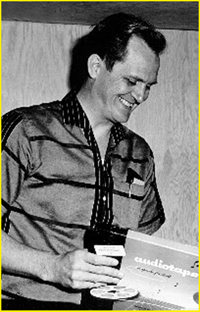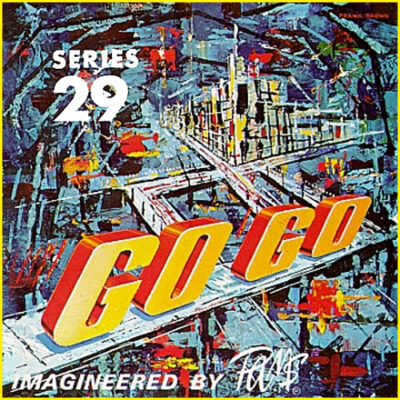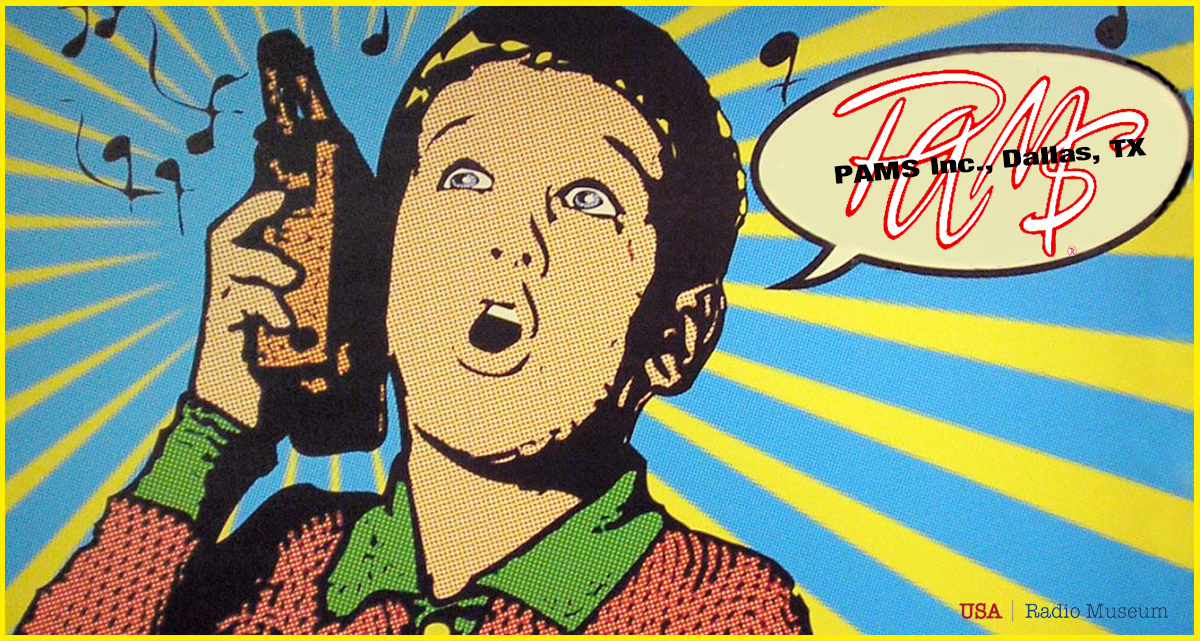Introduction: The Jingle Revolution In the world of radio broadcasting, few names evoke as much nostalgia and reverence as PAMS Inc. of Dallas,
Introduction: The Jingle Revolution
In the world of radio broadcasting, few names evoke as much nostalgia and reverence as PAMS Inc. of Dallas, Texas. Founded in 1951 by Bill Meeks, this groundbreaking company didn’t just create jingles—it transformed radio branding, shaping the sonic identity of stations across America and beyond. From the energetic tones of WABC (New York) to the rebellious offshore vibes of Wonderful Radio London, PAMS defined an era with its innovative jingle packages.
As we journey through the rich history of PAMS, we uncover how it revolutionized radio, shaped Top 40 formats, ventured into television advertising, and ultimately became a cultural phenomenon that still echoes today.
The Birth of a Jingle Empire

Bill Meeks circa 1958.
The story of PAMS begins with its visionary founder, William B. “Bill” Meeks, Jr., a musician and broadcaster passionate about sound. In 1947, Meeks worked at KLIF in Dallas, where he collaborated with staff singers to create custom station jingles. It was here that Meeks first explored the idea of using catchy melodies to establish a station’s identity.
Recognizing the branding potential of jingles, Meeks officially launched PAMS Inc. in 1951. The company introduced a revolutionary approach: instead of crafting individual jingles for each station, PAMS developed syndicated jingle packages. These pre-recorded backing tracks could be customized with station-specific lyrics, ensuring a consistent yet personalized sound across multiple markets.
One of PAMS’ first clients was KDNT in Denton, Texas, which purchased its first syndicated jingle package—a moment that marked the dawn of a new era in radio branding.
The Sound of Top 40 Radio
Throughout the 1950s, ’60s, and ’70s, PAMS’ jingles became synonymous with the Top 40 format, providing stations with high-energy, ear-catching musical branding. Some of the most iconic jingle packages included:
- Series 18 – “Sonosational”: A lush, orchestral sound favored by major stations.
- Series 27 – “Jet Set” (1964): Capturing the excitement of the era with brass instrumentation and sound effects.
- Series 31 – “Music Power”: Used by WABC (New York) to establish its dominance in hit radio.
- Series 40 – “Fun Vibrations”: A lively and playful package reflecting the spirit of the late ’60s.
- BBC Radio 1 & 2 Jingles: Created for the BBC’s launch in 1967, defining British pop radio branding.
Stations that used PAMS jingles immediately stood out, attracting listeners with the polished, energetic sound that became a signature of Top 40 radio.
PAMS | The Jet Set | WCPO 1230 (Cincinnati, OH)
Audio Digitally Remastered by USA Radio Museum
The Billboard 1970 Feature: PAMS’ Continued Industry Dominance
In late-1970, Billboard bannered an article about PAMS’ nearly 20-years of service, and it’s founder Bill Meeks:
” . . . It was on March 8, 1951, when it all started. Bill Meeks was a musician — a saxophone player — who worked in a staff band for WFAA, and then for KLIF, when Gordon McClendon put it on the air in 1947.
It was here that Meeks invented the concept of musical station breaks. He was the contractor for the station, and he sort of “put things together.” Leaving his saxophone (plus clarinet and flute) behind him, he went into time sales. He sold many accounts, began to form a good relationship with his clients, and then — inevitably — formed his own agency. That’s when he invented the PAMS name, only to have it given back. It would be the greatest bit of Indian giving in musical history.
Meeks began his musical jingles with a syndicated series, “We put a man on the road, cut the background music and sang the call letters over the music, customizing for each city,” he said.
The jingle impresario said he immediately began to check with the Union to be sure we were on safe ground. “As an old Union musician, I wanted to be sure. Petrillo told us to do our own thing in Dallas, whatever we thought best. He told us to ignore the rule that said the voice and sound must be done at the same time, so we did.” That rule of course, has since been changed. And Dallas has always continued to do its own thing, despite some pressure from unions in other cities.
PAMS had about 12 or 13 jingles in its first series, and 23 in its second. Series 3 was a disk jockey introduction. Series 4 was the first variable length station ID. Series 5 was a group of merchant jingles cut for Chevrolet dealers, and made available to the entire United States.
It Was Meek’s First Big Commercial Success
Series 6 was a new sound, using a group called the Moonmaids. On and on it went; rhythm and blues on one, a top 40 sound on another, all-male groups, all-female groups, mixed groups, mixed groups, station signatures, music logos, a living radio series, high school fight songs (done on location), sounds of the cities (with seasonal backgrounds), a New Frontier series, and then a pair of Sonovox series, with talking guitars, flutes, trombones, etc.
There were weather-ettes, “sonomagic and animajic” His and Hers Radio, an All-American series, a Jet Set thing utilizing “iconagentics,” a go-go series, pussycat, swisle, music power, the new generation, and modules. Right now Meeks and his associates are working on Series 41, which hasn’t yet been named. Musical contests are being put together at this time.” (Courtesy and credit: Billboard, November 21, 1970)
The November 1970 Billboard article showcased PAMS’ continued expansion and technological advancements. By 1970, PAMS had more than 1,000 clients, with state-of-the-art studios and a legendary creative team that included musicians like Glen Campbell.
PAMS wasn’t just producing jingles—it was shaping music for films, station contests, and experimenting with new sonic effects like Sonovox, talking flutes, and trombones.
Though PAMS remained dominant, Meeks hinted at a possible transition into the record industry, foreshadowing new creative ventures beyond traditional radio jingles.
Beyond Radio: Television and Advertising
While PAMS is best known for its radio jingles, the company also ventured into television advertising. In addition to producing station ID jingles, PAMS created commercial jingles for businesses and brands looking for a memorable sonic identity.
One of its early TV ventures was Series 5 – Merchant Jingles, which provided businesses with ready-to-use commercial jingles. Though radio remained its primary focus, PAMS’ influence extended into promotional campaigns and televised branding, further proving its adaptability and reach.
PAMS | Color Way [Learn to Play Guitar] | Ray Hurst Ads (1966-1967)
Audio Digitally Remastered by USA Radio Museum
The Decline and Enduring Legacy
 By the late 1970s, the radio industry saw shifts in programming styles, automation, and changing advertising strategies. As a result, PAMS suspended operations in 1978, marking the end of an era. However, this was not the end of its jingles—for the next 12 years, they continued under the CPMG/PAMS moniker, keeping the brand alive.
By the late 1970s, the radio industry saw shifts in programming styles, automation, and changing advertising strategies. As a result, PAMS suspended operations in 1978, marking the end of an era. However, this was not the end of its jingles—for the next 12 years, they continued under the CPMG/PAMS moniker, keeping the brand alive.
In 1990, PAMS was officially acquired by JAM Creative Productions, another Dallas-based jingle powerhouse. JAM ensured that PAMS’ legendary sound remained available for new generations by preserving its extensive jingle catalog and reviving classic packages with modern vocals.
PAMS jingles had a transformative impact on radio advertising and branding, revolutionizing how stations engaged with listeners. Here’s how:
1. Station Identification & Branding
- PAMS jingles provided catchy, memorable station IDs, making it easier for listeners to recall call letters and frequencies.
- Stations using PAMS jingles developed a distinct sonic identity, differentiating themselves from competitors.
2. Listener Engagement & Loyalty
- The upbeat, polished nature of PAMS jingles made radio stations sound exciting and professional, increasing listener retention.
- Jingles became part of the station’s personality, fostering a sense of familiarity and loyalty among audiences.
3. Influence on Top 40 Radio
- PAMS jingles played a crucial role in the success of Top 40 radio formats, making stations sound dynamic and fast-paced.
- Stations using PAMS jingles were often perceived as more modern and engaging, attracting younger audiences.
4. Syndication & Commercial Success
- PAMS pioneered jingle syndication, allowing stations nationwide to use high-quality jingles with customized lyrics.
- This cost-effective approach enabled smaller stations to maintain a professional sound without producing their own jingles.
Even after PAMS suspended operations in 1978, its jingles continued to shape radio branding. The company’s influence remains strong, with JAM Creative Productions preserving its legacy.
To those who want to explore more, check out PAMS’ detailed history here. Today, PAMS jingles are still accessible, thanks to efforts by JAM, the Media Preservation Foundation, and online archives like pams.com, where classic jingles can be heard.
Conclusion: The Timeless Impact of PAMS
PAMS Inc. was not just a jingle company—it was a revolution in branding. Its innovative syndicated packages, unforgettable melodies, and energetic sound helped define Top 40 radio, creating an audio experience that listeners didn’t just hear but felt as well.
Bill Meeks was the visionary founder of PAMS Inc., and his contributions to radio branding remain legendary, Meeks {b. March 2, 1921) revolutionized the industry by pioneering syndicated jingle packages, allowing stations to maintain a consistent yet customizable sound. His work shaped the identity of Top 40 radio, influencing major stations like WABC (New York), WLS (Chicago), and BBC Radio 1 & 2.
Meeks ran PAMS for 27 years, overseeing the creation of some of the most iconic jingles in broadcasting history. Even after PAMS suspended operations in 1978, his jingles continued to be produced under CPMG/PAMS until 1990, when JAM Creative Productions acquired the company, ensuring his legacy lived on.
Bill Meeks passed away on September 4, 1999 at the age of 78, leaving behind a timeless impact on radio branding.
From the booming harmonies of “Music Power” to the playful chants of “Fun Vibrations,” PAMS provided a soundtrack for radio’s golden age. Though the company ceased operations decades ago, its legacy is eternal—preserved by JAM Creative Productions and cherished by enthusiasts of radio history.
So, the next time you hear a catchy jingle, remember—it all started with the legendary PAMS Inc., the pioneers of radio’s most iconic brand of jingly sounds.


PAMS Truly paved the way for every jingle company from the word “Go, Go, GO!!!” as the PAMS Jingle Singers would say, and show Earth that Dallas-Fort Worth, Texas became of course “The Jingle Capital Of The World” in the 1st place all thanks to Bill Meeks and his people at………………….”P-A-M-S, PAMS Of Dallas!”